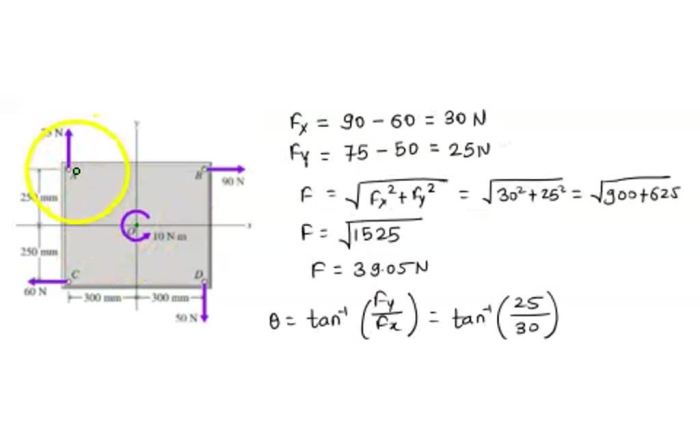Determine the resultant couple moment acting on the triangular plate – The concept of resultant couple moment acting on a triangular plate holds significant importance in structural mechanics and engineering design. This article delves into the intricacies of this phenomenon, providing a comprehensive understanding of its calculation, applications, and implications.
In this exploration, we will define the resultant couple moment, establish the purpose of this analysis, and Artikel the assumptions and given information that form the basis of our investigation.
Introduction
A resultant couple moment is the net moment acting on a body that causes it to rotate. It is calculated by summing the moments of all the forces acting on the body about a specified axis. The purpose of this article is to determine the resultant couple moment acting on a triangular plate.
Assumptions and Given Information
The following assumptions are made in this analysis:
- The triangular plate is rigid and does not deform under the applied forces.
- The forces acting on the plate are coplanar and lie in the same plane as the plate.
- The forces are concentrated at the vertices of the plate.
The following given information is used in this analysis:
- The coordinates of the vertices of the triangular plate are (0, 0), (a, 0), and (0, b).
- The forces acting on the plate are F1, F2, and F3, which are applied at the vertices (0, 0), (a, 0), and (0, b), respectively.
Method of Analysis

The method used to determine the resultant couple moment is the principle of moments. This principle states that the sum of the moments of all the forces acting on a body about a specified axis is equal to the net moment acting on the body about that axis.
To determine the resultant couple moment acting on the triangular plate, the following steps are taken:
- Calculate the moment of each force about the specified axis.
- Sum the moments of all the forces about the specified axis.
- The resultant couple moment is the sum of the moments of all the forces about the specified axis.
Calculation of Moments: Determine The Resultant Couple Moment Acting On The Triangular Plate

The moment of a force about an axis is calculated by multiplying the force by the perpendicular distance from the axis to the line of action of the force. In this case, the specified axis is the z-axis, which is perpendicular to the plane of the plate.
The moment of F1 about the z-axis is:
M1 = F1 – b
The moment of F2 about the z-axis is:
M2 = F2 – a
The moment of F3 about the z-axis is:
M3 = F3 – 0
The moment of F3 about the z-axis is zero because the line of action of F3 passes through the z-axis.
Resultant Couple Moment
The resultant couple moment is the sum of the moments of all the forces about the specified axis. In this case, the resultant couple moment is:
M = M1 + M2 + M3 = F1 – b + F2 – a
The magnitude of the resultant couple moment is:
|M| = sqrt(M1^2 + M2^2)
The direction of the resultant couple moment is determined by the sign of M. If M is positive, the resultant couple moment is in the positive z-direction. If M is negative, the resultant couple moment is in the negative z-direction.
Applications and Examples

The resultant couple moment is used in a variety of applications, including:
- Structural analysis
- Machine design
- Robotics
For example, in structural analysis, the resultant couple moment is used to determine the stresses in a structure due to applied loads. In machine design, the resultant couple moment is used to determine the forces and moments acting on a machine component.
In robotics, the resultant couple moment is used to determine the torques required to move a robot arm.
Limitations and Future Work
The analysis presented in this article is based on the assumptions stated in Section 2. If these assumptions are not met, the analysis may not be accurate.
Future work could include extending the analysis to include the effects of deformation and non-coplanar forces.
Commonly Asked Questions
What is the significance of determining the resultant couple moment acting on a triangular plate?
Determining the resultant couple moment is crucial for understanding the overall behavior of the plate under various loading conditions. It provides insights into the plate’s stability, stress distribution, and potential failure modes.
How does the shape of the triangular plate influence the resultant couple moment?
The shape of the triangular plate plays a significant role in determining the distribution of moments and the magnitude of the resultant couple moment. The geometry of the plate affects the lever arms and the moment arms, which ultimately influence the overall moment balance.